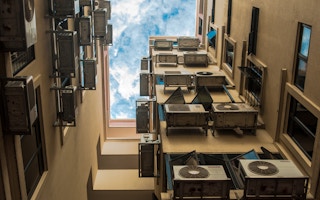Representatives from more than 170 countries agreed to limit and eventually stop all uses of HFCs, or hydrofluorocarbons – climate change-exacerbating chemicals commonly used in refrigerators and air conditioning units – on Friday in Kigali, Rwanda.
Though the much-heralded climate change agreement reached in Paris in 2015 is broader in its scope, employing reduction strategies and offsetting schemes to slash carbon dioxide emissions, experts believe that the pinpoint focus of the Kigali deal and the fact that it’s legally binding – which the Paris Accord is not – mean it could be hugely effective at staunching the warming climate.
Andrew Light, a Distinguished Senior Fellow at the World Resources Institute (WRI) and former advisor on climate change at the U.S. Department of State, called the move “the single most important measure the global community could take to limit global warming in the short term,” according to a press release from WRI.
The agreement sets out to cut HFC levels by 80 to 85 percent by 2047.
HFCs “are thousands of times more potent” at trapping heat in the atmosphere than carbon dioxide, Light explained in the WRI statement. As a result, “a successful phase down can avoid up to a half a degree Celsius of global warming by the end of this century,” he said.
The Kigali Amendment was adopted to the Montreal Protocol, put forth in 1987 to find ways to get rid of chemicals that, since the advent of the Industrial Revolution, have caused the worrying loss of the ozone layer of Earth’s atmosphere – that gaseous shield that screens us from ultraviolet radiation.
“
The plan provides financing to countries in need, so that new air conditioning and refrigeration technology can be available for their citizens.
U.S. president Barack Obama
The layer’s disintegration in the 20th century is often blamed for the uptick in health problems such as skin cancer and cataracts. If the Montreal Protocol is fully adopted, scientists predict that the ozone layer could return to what it was before the Industrial Revolution in as little as four to six decades.
Though the conference lasted just a single week in Kigali, Light said the new pact has been in the works much longer.
“Achieving this historic agreement was hard fought over nearly a decade of leader-level negotiations, and a result of thousands of contributions from businesses, non-governmental organizations, and faith communities,” he said.
In a statement issued after the adoption of the agreement, U.S. Secretary of State John Kerry pointed toward building momentum in the global community for finding climate change solutions.
“The Kigali Amendment is just the latest example of the tangible progress the world is making to address climate change,” Kerry said. “Just last week, the Paris Agreement reached the thresholds to enter into force – the fastest entry into force of a global environmental agreement ever – and we also adopted a measure aimed at carbon neutral growth in the international aviation sector.”
Andrew Light added that representatives from many countries have come to see the importance of this step: “Over time an astonishing array of countries — from the largest developed and emerging economies to the most poor and vulnerable states — united to take this bold step to tackle the common threat of climate change.”
The accord hammered out in Kigali lays out a three-tiered timeline for countries to adopt the “phase down” of HFC usage. The wealthiest signatories to the agreement, including the U.S., have agreed that their use of HFCs will peak in 2018 and they’ll reduce their use to a fraction of 2012 levels by the middle of the century.
Most others, including the entire African continent, will “freeze” their use of HFCs by 2024. A handful of the warmest places on earth, such as India, Saudi Arabia and Kuwait, will have a bit longer, until 2028.
However, concern has surfaced about inhabitants of developing and emerging countries and how they will afford more expensive alternatives to HFCs under the terms of this agreement to keep themselves, their perishable food and medications cool in a warmer future.
Still, U.S. President Barack Obama said all parties to the agreement will get the support they need to meet these targets.
“The plan provides financing to countries in need, so that new air conditioning and refrigeration technology can be available for their citizens,” Obama said in a statement released by the White House press secretary.
“It shows that we can take action to protect our planet in a way that helps all countries improve the lives and livelihoods of their citizens.”
This story was published with permission from Mongabay.com










